Related Research Articles
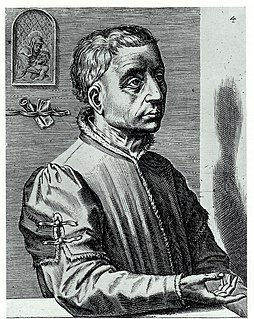
Rogier van der Weyden or Roger de la Pasture was an Early Netherlandish painter whose surviving works consist mainly of religious triptychs, altarpieces, and commissioned single and diptych portraits. He was highly successful in his lifetime; his paintings were exported to Italy and Spain, and he received commissions from, amongst others, Philip the Good, Netherlandish nobility, and foreign princes. By the latter half of the 15th century, he had eclipsed Jan van Eyck in popularity. However his fame lasted only until the 17th century, and largely due to changing taste, he was almost totally forgotten by the mid-18th century. His reputation was slowly rebuilt during the following 200 years; today he is known, with Robert Campin and van Eyck, as the third of the three great Early Flemish artists, and widely as the most influential Northern painter of the 15th century.

Robert Campin, now usually identified with the Master of Flémalle, was the first great master of Early Netherlandish painting. While the existence of a highly successful painter called Robert Campin is relatively well documented for the period, no works can be certainly identified as by him through a signature or contemporary documentation. A group of paintings, none dated, have been long attributed to him, and a further group were once attributed to an unknown "Master of Flémalle". It is now usually thought that both groupings are by Campin, but this has been a matter of some controversy for decades.

The Mérode Altarpiece is an oil on oak panel triptych, now in The Cloisters, in New York City. It is unsigned and undated, but attributed to Early Netherlandish painter Robert Campin and an assistant. The three panels represent, from left to right, the donors kneeling in prayer in a garden, the moment of the Annunciation to Mary, which is set in a contemporary, domestic setting, and Saint Joseph, a carpenter with the tools of his trade. The many elements of religious symbolism include the lily and fountain, and the Holy Spirit represented by the rays of light coming through from the central panel's left hand window.

The Master of the Legend of the Magdalen was an Early Netherlandish painter, active from about 1483 to around 1527. He has not been identified; his name of convenience is derived from a large, now-dispersed altarpiece with scenes from the life of Mary Magdalene, which has been dated to between 1515 and 1520 based on the costumes of the donor portraits. However other works attributed to him are extremely difficult to date with any accuracy. Many paintings have been linked with the triptych, which is thought to have been finished late in the artist's career. Other major works include his two Magdalen panels in London.

The Descent from the Cross is a panel painting by the Flemish artist Rogier van der Weyden created c. 1435, now in the Museo del Prado, Madrid. The crucified Christ is lowered from the cross, his lifeless body held by Joseph of Arimathea and Nicodemus.

Portrait of a Lady is a small oil-on-oak panel painting executed around 1460 by the Netherlandish painter Rogier van der Weyden. The composition is built from the geometric shapes that form the lines of the woman's veil, neckline, face, and arms, and by the fall of the light that illuminates her face and headdress. The vivid contrasts of darkness and light enhance the almost unnatural beauty and Gothic elegance of the model.
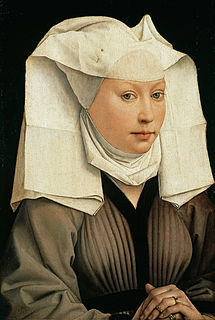
Portrait of a Young Woman is a painting completed between 1435–1440 by the Netherlandish artist Rogier van der Weyden. The sitter in this small work wears a wide, white hennin over a brown dress, which features a black-lined, v-shaped neckline. As is usual of van der Weyden's female portraits, her hands are clasped tightly in prayer, while her expression is generally humble. Unusually for a van der Weyden', she does not bow her head or gaze into the middle distance. Instead she looks directly at the viewer, creating an intimate relationship between sitter, viewer and artist, which art historian and research curator Lorne Campbell describes as "appealing and vibrant".

The Magdalen Reading is one of three surviving fragments of a large mid-15th-century oil-on-panel altarpiece by the Early Netherlandish painter Rogier van der Weyden. The panel, originally oak, was completed some time between 1435 and 1438 and has been in the National Gallery, London since 1860. It shows a woman with the pale skin, high cheek bones and oval eyelids typical of the idealised portraits of noble women of the period. She is identifiable as the Magdalen from the jar of ointment placed in the foreground, which is her traditional attribute in Christian art. She is presented as completely absorbed in her reading, a model of the contemplative life, repentant and absolved of past sins. In Catholic tradition the Magdalen was conflated with both Mary of Bethany who anointed the feet of Jesus with oil and the unnamed "sinner" of Luke 7:36–50. Iconography of the Magdalen commonly shows her with a book, in a moment of reflection, in tears, or with eyes averted.
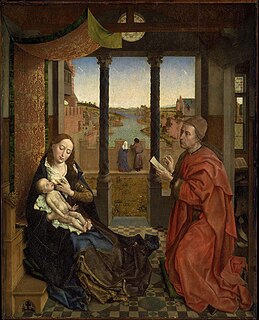
Saint Luke Drawing the Virgin is a large oil and tempera on oak panel painting, usually dated between 1435 and 1440, attributed to the Early Netherlandish painter Rogier van der Weyden. Housed in the Museum of Fine Arts, Boston, it shows Luke the Evangelist, patron saint of artists, sketching the Virgin Mary as she nurses the Child Jesus. The figures are positioned in a bourgeois interior which leads out towards a courtyard, river, town and landscape. The enclosed garden, illusionistic carvings of Adam and Eve on the arms of Mary's throne, and attributes of St Luke are amongst the painting's many iconographic symbols.

Virgin and Child is a small c. 1485–90 double hinged oil on oak triptych with a central panel by a follower or workshop member of the Flemish painter Hugo van der Goes or Gerard David. The work is currently held in the National Gallery, London with the central panel in its original frame. The central image is a tightly cropped and intimate portrayal Mary cradling the infant Jesus, who plays with a red rosary tied around his neck.

Virgin and Child with Saints, is a large mid-15th century oil-on-oak altarpiece by the early Netherlandish painter Rogier van der Weyden. The work is lost since at least the 17th century, known only through three surviving fragments and drawing of the full work in Stockholm's Nationalmuseum by a follower of van der Weyden. The drawing is sometimes attributed to the Master of the Drapery Studies.

The Magdalen Weeping is an oil on oak panel painting attributed to the workshop of the unidentified Early Netherlandish artist known today by the notname the Master of the Legend of the Magdalen, active in Brussels. Although beautiful, the painting is significantly damaged and has been restored and overpainted a number of times since the 19th century; not always successfully and the impact of the image is considered to have been lessened as a result.

Durán Madonna is an oil on oak panel painting completed sometime between 1435 and 1438 by the Netherlandish painter Rogier van der Weyden. The painting derives from Jan van Eyck's Ince Hall Madonna and was much imitated subsequently. Now in the Prado, Madrid, it depicts a seated and serene Virgin Mary dressed in a long, flowing red robe lined with gold-coloured thread. She cradles the child Jesus who sits on her lap, playfully leafing backwards through a holy book or manuscript on which both figures' gazes rest. But unlike van Eyck's earlier treatment, van der Weyden not only positions his Virgin and Child in a Gothic apse or niche as he had his two earlier madonnas, but also places them on a projecting plinth, thus further emphasising their sculptural impression.

Portrait of Antoine, 'Grand Bâtard' of Burgundy is an oil panel painting by the Netherlandish painter Rogier van der Weyden portraying Anthony of Burgundy, the bastard son of Philip the Good and one of his mistresses, Jeanne de Presle. The panel is dated to about 1460 and held in the Royal Museums of Fine Arts of Belgium, Belgium. He wears the livery collar of Order of the Golden Fleece, a chivalric order established January 10, 1430, by Philip the Good, Duke of Burgundy. In 1456 Anthony was inducted into the prestigious Order, held by only 29 others at that time. The exact significance of the arrow held in the bastard's hand is unknown, although the fleece is thought to refer to either the Greek mythological hero Jason or the Hebrew warrior and judge Gideon.

The Annunciation Triptych is an oil-on-panel triptych by the Netherlandish artist Rogier van der Weyden, dating from around 1434. It was originally formed by three panels, the central one being now at The Louvre museum in Paris, France; the side panels are at the Galleria Sabauda of Turin, northern Italy.
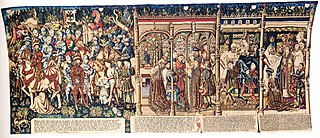
The Justice of Trajan and Herkinbald was a set of four large panels painted by the Flemish painter Rogier van der Weyden that decorated one wall of a court-room in the Town Hall of Brussels. They represented the Justice of Trajan, a Roman emperor, and the Justice of Herkinbald, a legendary Duke of Brabant. The panels were intended as a reminder to judges to dispense impartial justice and were admired by generations of visitors, including Albrecht Dürer. They were destroyed when the city was bombarded by the French in 1695 and are now known only from descriptions and from a tapestry copy in the Historical Museum of Bern.

Pietà is a painting by the Flemish artist Rogier van der Weyden dating from about 1441 held in the Royal Museums of Fine Arts of Belgium, Brussels. There are number of workshop versions and copies, notably in the National Gallery, London, in the Prado, Madrid, and in the Manzoni Collection, Naples. Infrared and X-radiograph evidence suggest that the Brussels version was painted by van der Weyden himself, not necessarily excluding the help of workshop assistants. Dendrochronological analysis gives a felling date of 1431 for the oak panel backing, supporting the dating of the painting to around 1441.
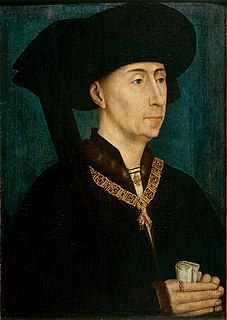
Portrait of Philip the Good is a lost oil on wood panel painting by the Early Netherlandish painter Rogier van der Weyden, dated variously from the mid 1440s to sometime after 1450.
Jan Van der Stock is a Belgian art historian and exhibition curator. He is a full professor at the University of Leuven, where he lectures on Medieval and Renaissance Arts, Graphic Arts, Iconography, Iconology, and Curatorship. He is the director of Illuminare – Centre for the Study of Medieval Art and holder of the Van der Weyden Chair – Paul & Dora Janssen, the Veronique Vandekerchove Chair of the City of Leuven and the Chair of Medieval Sculpture in the Low Countries. Jan Van der Stock was the husband of Prof. dr. Christiane Timmerman and is the father of Willem and Liza Van der Stock.

A Man and A Woman is the title sometimes used for a pair of oil and egg tempera on oak panel paintings attributed to the Early Netherlandish painter Robert Campin, completed c. 1435. Although usually considered pendants or companion pieces, they may also have been wings of a since dismantled diptych. The latter theory is supported by the fact that the reverse of both panels are marbled, indicating that they were not intended to be hung against a wall.
References
- ↑ "Laudatio for Professor Lorne Campbell", Delivered in Leuven on 20 October 2016 by Professor Jan Van der Stock, promotor doctor honoris causa
- ↑ "Interview met kunsthistoricus Lorne Campbell", 2016
- ↑ Campbell, Lorne. Van der Weyden. London: Chaucer Press, 2004. ISBN 1-904449-24-7
- ↑ "KU Leuven awarded an honorary doctorate to Lorne Campbell". Illuminare. Retrieved 4 August 2019.
- ↑ "Conference in Honour of Lorne Campbell on his 65th Birthday Archived 2 December 2013 at the Wayback Machine ". Courtauld Institute of Art, December 2011. Retrieved 12 February 2012.
- ↑ "(Ian) Lorne Campbell. National Portrait Gallery (London). Retrieved 12 February 2012.
- ↑ Savage, Michael. "Sixteenth Century Netherlandish Paintings in the National Gallery". Grumpy Art Historian, 27 July 2014. Retrieved 20 June 2015.
- ↑ "Eredoctoraat uitgereikt aan wereldvermaard kunsthistoricus Lorne Campbell". KU Leuven. Archived from the original on 2 February 2017. Retrieved 26 October 2016.